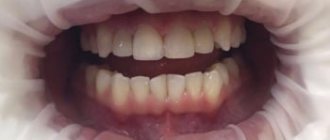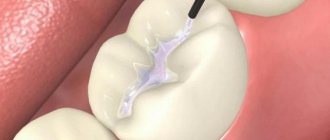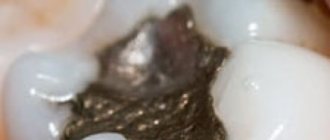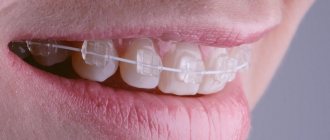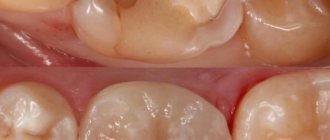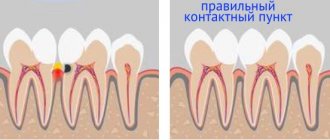Nature does not always give us an even and snow-white smile. This will leave some indifferent, but the majority will still choose correction using braces, which gradually move the teeth into an even row. Along with braces, if the clinical situation requires it, overbite fillings are often used. Devices that at first cause a lot of inconvenience and a large number of not just negative, but even indignant responses.
Why you need to be patient and give yourself time to get used to installing these fillings is in this material.
Overbite fillings - what are they?
Often teeth in the same row differ slightly in height, some of them may protrude forward or move back slightly. If everything is left as is, over time the situation will worsen: due to incorrect position, individual elements will be subject to increased wear and tear, and over time will begin to deteriorate and collapse, which will become a favorable environment for the development of carious processes. But even with braces, the difference in the height of some teeth does not disappear, and sometimes becomes more pronounced. Overbite fillings will help solve this problem, and this is why they are needed: such overlays do not allow antagonist teeth to contact each other in the wrong plane.
Important! Incorrect contact of opposing teeth on the lower and upper jaws can lead to damage to the brace system and the plates coming off. The teeth themselves are also under attack; for example, there is a risk of serious damage to the enamel and even injury to deeper dental tissues.
Overbite fillings are a kind of overlays for teeth
Thus, a bite filling is a temporary solution, which, unlike standard fillings, has a slightly larger caliber. These are a kind of overlays designed for fixation on both upper and lower crowns, depending on the location of the defect. In pediatric orthodontics, the use of colored materials to create such elements is actively practiced. However, they are not sufficiently durable, so they are changed several times during the entire course of treatment.
Reviews
Along with braces, I had bite fillings installed on two teeth. The first week was very uncomfortable. Unable to chew food. Even my diction changed and a lisp appeared. After some time, I got used to the new position, and my teeth began to gradually straighten out. Therefore, if there is a need to install a seal, then it is better to install it.
Anzhelika, Moscow
They put 4 fillings along with braces. One of them fell off after a month. The doctor changed it, but made it not so large. This was noticeable while eating. I had to wear fillings for almost a year and a half. Therefore, if someone is given them for 6 months, this is nonsense. But now I have the correct bite, good diction and an attractive smile.
Nina, Kostroma
Indications for installation of overbite fillings
The installed overlay does not allow the jaws to close completely; it prevents close contact between the antagonist teeth, which are still in an incorrect position. Such fillings are fixed after installing braces if there is a risk of damage to the enamel or brackets. Here are the main indications for their installation:
- the teeth on the upper and lower jaws have different heights, which is especially common with abnormally large lower incisors,
- unilateral or bilateral crossbite,
- incorrect relationship between the shapes of the jaw arches,
- strongly protruding upper incisors, which almost completely overlap the lower ones,
- small height of the crowns against the background of strong abrasion of their marginal surface.
Such designs are used for different heights of the upper and lower teeth.
Upon completion of the course of orthodontic treatment, the onlays are removed, and the remaining errors are corrected by filing, permanent filling, or even installing crowns.
Who should have braces on their teeth?
When the dentition is deformed, it is visually difficult to determine whether it is necessary to install braces or whether you can do without them. In any case, consultation with an orthodontist cannot be avoided.
Only diagnostic studies can be an indicator for decision making.
If the doctor sees that the jaw is in the stage of intensive growth, and the curvatures are insignificant, then it is possible to do without installing a brace system. Or, as an option, postpone the procedure for some period, continuing to monitor the formation of the dentition.
Orthodontic structures are installed according to medical indicators:
- with the wrong direction of growth of permanent teeth;
- the need for bite correction;
- to eliminate the negative consequences of injuries or congenital pathologies.
In particularly difficult cases, when the roots of the teeth are intertwined, surgical intervention is necessary, followed by fixation with braces. This treatment option can be quite lengthy but is quite effective.
In what cases is installation contraindicated?
Overbite fillings cannot be installed in all cases. For example, such solutions are contraindicated in case of oncological pathologies, systemic lesions of gum and periodontal tissues, allergic reactions and deep caries, if the patient suffers from neuropsychiatric disorders, bruxism (with the exception of a cement filling), tuberculosis, diseases of the blood and hematopoietic organs, or serious disruptions in the functioning of the endocrine system. At the same time, increased demands are placed on maintaining an adequate level of oral hygiene, but this condition is, in principle, true for orthodontic treatment with braces.
Hygiene
In addition to installing braces and fillings, you should know the basic rules for maintaining oral hygiene:
- Before putting on the removable plate, it should be rinsed with clean water. There are special solutions in which the plate should be immersed while brushing teeth or eating. If the Khurgina system is used, the sliding screw is additionally lubricated with vegetable oil.
- To brush your teeth, it is recommended to use a soft-fiber toothbrush, as well as toothpaste prescribed by your doctor.
- If the patient’s life is closely connected with sports, then it is recommended to remove the device during physical activity.
- In addition to the solution, it is recommended to use special gels that additionally disinfect the surface of the plates and also remove unpleasant odors.
Following the above recommendations reduces the risk of caries, bleeding gums and other diseases associated with the oral cavity.
Types of systems and materials used
In orthodontic practice, various models of such products are used, and they can be made of different materials. The choice of a specific solution directly depends on the characteristics of the clinical picture, its complexity, as well as on the design features of the brace system. Let's consider each of the options in more detail.
Classic Katz model
This is a removable palatal structure in the form of a bite plate, which is created from special plastic. The device is fixed on the premolars of the upper jaw using clasps (hooks). The plate itself is not adjacent to the frontal zone, but the support is on the front teeth. The chewing muscles create the necessary pressure, due to which, when the jaws are closed, the force of influence passes to the frontal area.
The photo shows the classic Katz model
This model is mainly used to correct prognathia, an anomaly in which the upper front teeth protrude far forward and overlap the lower incisors. The action of the plate occurs in two directions at once: the front incisors are shortened, and the lateral incisors are lengthened, while the lower teeth and jaw arch are shifted in the right direction1.
Khurgina model with an expanding screw mechanism
The system is often fixed when correcting a deep distal bite due to a narrowing of the upper jaw. Essentially, this is the same Katz model, only supplemented with an expanding screw mechanism, the action of which is aimed at stretching the jaw arches. The model requires only periodic activation, usually once every 5-7 days. Each revolution of the expansion screw creates pressure on the alveolar processes and teeth, promoting a gradual and uniform advancement of the lower jaw forward.
This is what the Khurgina model looks like with an expanding screw mechanism
Artificial dentin (aqueous dentin)
Next we will talk about the materials that are used to create such overlays. So, for example, artificial dentin is created on the basis of distilled water in combination with a special powder, the composition of which includes zinc oxide, sulfate and kaolin. The mixture is diluted with water until a viscous consistency is obtained, after which the required amount is applied to the chewing surface. The composition hardens within 3-4 hours. Among the shortcomings, experts highlight the insufficient strength of the material, which is why dentin lasts only 2-3 days.
Artificial dentin lasts no more than 3 days
Features of using dentin paste
The composition of the material is similar to the previous one with the only difference being that instead of distilled water, clove or peach oil is added to the powder. This component creates an additional antiseptic treatment. For complete hardening of the composition, about 1.5-2 hours are enough. The material is quite sticky, which makes the orthodontist’s work somewhat more difficult. To prevent the paste from sticking to the instrument, I use a cotton swab dipped in water.
Dentin paste is also used for these purposes.
Overbite cement fillings
The cement base is characterized by increased strength and wear resistance. To create such fillings, zinc phosphate or polycarboxylate cement is used. The material is relevant for correcting severe jaw abnormalities. It is even used in cases where the patient suffers from bruxism, the inevitable consequence of which is severe abrasion of the enamel. Among the disadvantages, experts highlight the lack of aesthetics, as well as poor resistance to the aggressive influence of saliva and the moist environment of the oral cavity in general.
Zinc phosphate cement is characterized by strength and wear resistance
Characteristics of polymer materials
These are more elastic materials, with which the installation and dismantling of bite fillings becomes simpler and faster. The composition has good adhesion, due to which it holds tightly and is characterized by increased wear resistance. In this case, there is no need to carry out additional manipulations to process the finished filling. The composition quickly hardens under the influence of a special light lamp.
Advantages and disadvantages
Contraindications are associated with:
- With diseases of the endocrine or cardiovascular systems, as well as with chronic inflammatory diseases of the oral cavity
- Persistent pain while wearing, eating, talking.
- A destroyed plate, if the material used in its manufacture turned out to be of poor quality and/or defective.
- The need for mandatory preliminary prosthetics if one or more teeth are missing on either side of the jaws. The bite can be corrected only after this, but the process will be complicated by the presence of dentures or crowns in the mouth; its dynamics in this case change.
Advantages:
- Correction of dental defects in the shortest possible time, compared to the non-use of bite fillings.
- Reducing or even completely eliminating damage to bracket arches or all fastenings on the teeth of opposite jaws.
- Painless bite correction.
- Elimination of inevitable pathologies in the form of pressure on tissues, which always accompany tooth shifting during braces.
- Normalization of the secretion of digestive enzymes associated with good grinding of food in the mouth.
- Guaranteed, repeatedly tested hypoallergenicity of the components included in the bite fillings.
Children's and adult fillings are practically no different. The only difference may be that brightly colored material is used for children: blue, orange, red. “Adult” fillings are usually white, matching the color of the teeth. Sometimes they are colorless and transparent.
How the overlays are fixed
Fixation of the filling material is carried out in a dental office. To begin with, the orthodontist prepares the composition, after which he applies the required amount to the teeth, often on both jaws at once, on those elements that come into contact with each other. When using polymer materials, a special LED lamp is used to harden them. At the end of all manipulations, the excess composition is carefully removed - sanded off.
The procedure is completely painless, but problems may arise during the adaptation stage. According to patient reviews, many are faced with pressing questions about how to start eating and talking normally with bite fillings in the mouth. In fact, diction problems and some discomfort at first are completely natural and natural phenomena. There is no need to worry about this, since addiction will still happen. Some people just need a little more time to adapt, others less.
The photo shows a diagram of the installation of a bite filling
How to install the device
The orthodontist takes the appropriate material and simply applies it to the teeth in the required amount, then exposes it to a lamp or other activator. If necessary, the doctor additionally sands off excess material. Does it hurt? No, the procedure is painless, and you can rest assured about the integrity of the teeth on which these types of fillings are placed - the enamel is not subjected to preparation.
What are the advantages?
Installing such elements helps solve a complex of problems at once. Experts in the field of orthodontics include the following functions as additional features:
- faster correction of malocclusion, which is due to additional impact on the dentition,
- reducing traumatic pressure on the gums and jawbone,
- increase in bite height by 2 mm or more,
- improving the quality of chewing food after correction, and therefore eliminating problems with the stomach and digestion,
- reducing the risk of spraining the jaw ligaments and eliminating discomfort during talking and chewing food,
- reducing tooth wear.
With such fillings, bite correction is faster.
Before starting the course of treatment, the patient must undergo preparation: elimination of carious processes, removal of dental plaque, etc. Overbite fillings, although they look like ordinary ones, only slightly enlarged, but they do not protect against the development of caries. Therefore, all pathological phenomena in the oral cavity must be eliminated in advance.
Structure and features
The bite plates, for the most part, consist of the following elements:
- base platform , which prevents the closure of the dentition;
- metal clasps (clamps, staples) securing the plates
- labial arch , through which the clasps are connected.
In some cases, the plates are fixed not with clasps, but with the help of a rubber rod, when the arch is attached to the molars with special rings.
All designs are equipped with support for the upper palate and front teeth and differ only in some elements. There are separate models that can be removed.
Characteristic features of fillings include:
- affordability;
- adhesion strength to the tooth surface;
- ease of use;
- ease of removal.
A bite filling is used as an onlay and does not harm the tooth surface, but it must be strong enough not to be destroyed when chewing, so the type of material chosen for manufacturing is of great importance.
Adjustment period, proper care and nutrition
Immediately after the installation of onlays or plates, patients inevitably have questions about how to chew now and get rid of a lisp if the jaws do not close completely. Everyone experiences discomfort while eating and talking, but over time the jaws adapt, diction is restored, the person begins to chew food normally and no longer experiences significant discomfort. If the discomfort turns into intense pain, it is better to contact your orthodontist - the system may be installed incorrectly.
“At one time I spent about 9 months with a bite plate. I admit, it was not easy for me personally. At first it was very difficult to chew. I constantly bit my tongue and swallowed large pieces. Then everything became easier. You just need to get used to them, get the hang of it. After they were removed, I got used to it again for about a week. It felt like there were no teeth in my mouth at all. In general, it’s not a particularly pleasant thing, but it’s necessary, so what can you do..."
LevaX, from correspondence on the forum www.32top.ru
As for care, the presence of such additional corrective elements in the mouth does not require any additional manipulations other than those that constitute the basic rules of oral hygiene. But it’s better to reconsider your diet. On the other hand, the recommendations are the same as after installing braces without any additional elements:
- priority should be soft and liquid foods, such as purees, soups and yoghurts,
- It is better to cut the products into small pieces,
- you will have to give up too hard and viscous foods,
- You should avoid biting into hard vegetables and fruits,
- no nuts, seeds, chewing gum or toffees during the entire correction period.
If the filling is damaged, just like if a brace breaks or comes off, you should contact your orthodontist as soon as possible. He will correct or completely replace the damaged element.
Nutrition rules: what you can and cannot eat
The rules here are standard - if you wear braces, you already have to put up with them:
- Eliminate solid foods from your diet to avoid damaging your bite fillings: say no to nuts, whole fruits and vegetables, candies,
- impose a ban on crumbly and sticky foods so that the fillings do not fall out prematurely: you cannot eat cookies, toffees, chips and crackers,
- Avoid food that is too hot or too cold to avoid damaging the integrity of the materials.
At first, during the period of getting used to the structures and when feeling severe discomfort, patients on various forums advise each other to eat soups and purees, as well as dishes crushed using a blender. This is not without meaning, but still it is not worth switching to such food on an ongoing basis - the jaw system must receive a load and function fully.
Overbite fillings and plates are different concepts
In orthodontic practice, special plates are also actively used, which prevent the jaws from completely closing in order to avoid injury to the teeth and parts of the brace system. Unlike single linings, these are more complex designs, which include the Katz and Khurgina models. Typically such a device includes the following elements:
- an arc that connects the clasps to each other,
- a plate that helps move teeth in the desired direction,
- clasps are hooks that are fixed on the supporting teeth.
Overbite filling (Katz model) and plates are different concepts.
The plate is attached in the palatal position on the front teeth. Such a device additionally helps to relax the chewing muscles, which are often toned due to the presence of a large number of non-removable elements in the mouth. Sometimes elastic rods are used instead of clasps to secure the structure.
Contraindications and side effects
A contraindication for installation is tooth decay, which requires preliminary restoration of the integrity of the walls. Protection is not done if the constituent components are intolerant. Infections of the oral cavity and some endocrine diseases may also be a contraindication to the use of a temporary structure.
On a note!
Often, after installation, patients are faced with the fact that they do not know how to chew food. Discomfort occurs due to the fact that the material does not allow the teeth to close in their previous usual position. The patient needs to be patient. The adaptation period lasts on average 1 – 7 days. After this, the patient gets used to the new conditions, which will still have to be adapted to after the bite is corrected.
What to do if the material is damaged
During orthodontic treatment, the patient will in any case have to visit his orthodontist at least once every couple of months, or even more often - it is necessary to adjust the system and carefully monitor the strength of its effect on the teeth and bite as a whole. Overbite fillings are usually not durable and wear-resistant, so they will have to be changed more than once during the entire course of therapy. This is also associated with their frequent damage and loss. If the material has chipped, the problem can be corrected by touch-up. For more serious injuries, the doctor will simply replace it.
The use of bite fillings and plates allows not only to protect teeth from abrasion and destruction, but also to prevent damage to brackets, and also to significantly speed up the process of correcting defects - making treatment faster and more effective.
- Gerasimov S.N. Fixed orthodontic technique, 2002.
All about fillings that will help protect teeth and braces from damage
Many patients, when preparing to install braces, hear from friends or read on forums on the Internet stories about the application of overbite fillings, which cause quite severe discomfort, interfere with chewing, closing the jaws and even speaking. After this, people no longer want to wear braces. It's time to dispel all the myths regarding bite fillings and figure out why they are needed and how to use them correctly.
Where to go?
Usually, parents notice a crooked dentition in their child when baby teeth are replaced by permanent teeth. If such a problem exists, there is a direct path to the orthodontist. It is this specialist who determines whether braces are needed on the teeth. In addition, any imperfections can be corrected not only in adolescence. Narodnaya dental specialists have experience in successfully correcting the dental system of patients of various age categories.
If the decision to install the structure is positive, the orthodontist plans the procedure in detail and calculates the result of the treatment. An initial visit to the clinic involves the following studies:
- examination of the oral cavity to identify teeth requiring sanitation;
- current level of hygiene;
- condition of wisdom teeth
- familiarization with the types of bracket systems;
- referral for diagnostics.



